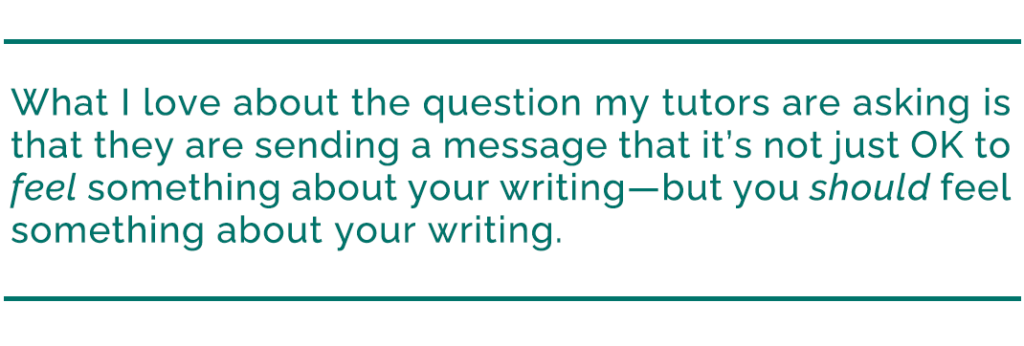By Elizabeth Parfitt, Penn State University
As a writing center administrator, I observe 15-20 new writing tutors each semester to provide them with constructive feedback toward their development as tutors, scholars, and writers.
Typically, these observations are routine. I find myself marveling at how talented and hardworking our tutors are while also making sure they know they’re working a bit too hard when they veer into more directive tutoring territory. It’s a part of my job that is time consuming but a highlight. When I’m sitting next to a writer and tutor, watching them move an idea forward, I feel connected to the writing center and the possibilities that tutoring affords. I feel confident that the work we’re doing is making a difference on campus.
This overt emotional connection to the work might also explain why I honed in on a curious trend during my observations this past year. I noticed many of my tutors asking the same question at the start of their tutorials. The inquiry came as a common refrain just after writers read their work aloud.
“How do you feel about this project?”
The tutors would then sit back and wait. Pause. Provide time for the writer to consider what they were asking.

Besides the fact that it seems a rarity in our task-driven culture for someone to slow down and ask about our feelings, this question hit me hard because I couldn’t recall explicitly teaching students to ask it. While most writers I observed answered the question with a typical, “I feel OK about it,” or “I feel pretty good,” there are always students who admit to serious self-doubt in tutorials. It wouldn’t be strange to hear “It feels all over the place” or even “I hate it,” as a response to this question. Like writing itself, tutorials are a dynamic social process and these tutors were inviting writers to open up and express the emotional impact of writing in their sessions.
As an intellectual task, those tutors are asking writers to reflect on their work—something I do explicitly teach in my training courses. And to be honest, I’m sure I’ve used the question now and then myself, leading experienced tutors to pick it up on the fly. It rolls off the tongue as quickly as “what do you think about this project?” While praxis might persuade us that “feel” is merely a synonym for “think,” Gibbs’ reflective theory reveals that feeling is the precursor to meaning making and, later, action. Scholars like Bonnie Devet already incorporate this reflective work into tutor training.
But I found myself more curious about how the tutors were using the information they received. Did they really want to know how a writer was feeling or were they searching for something different in that response? And if, as I suspect, the true meaning of that question is somewhere in between—something more about the writing process—how could I start to turn a question that felt like repeated staff lore into a practice that tutors could replicate?
Feeling Our Way Through the Writing
The first concept that comes to mind when I think about writing and emotion is Sondra Perl’s 1980 classic essay, “Understanding Composing.” For me, Perl’s piece was a slow burn. It took many years and many reads, before I fully came to terms with Perl’s ideas. If you’ve never read it, Perl argues that writing is a recursive process that involves re-reading, re-thinking the topic, and—above all else—looking back in order to move forward with a draft. But equally as important is the feeling that accompanies this recursive process—a term Perl borrows from philosopher Eugene Gendlin: “the felt sense.”
In the recursive writing process, the felt sense is sort of like an informed intuition. Perl explains, “The move draws on sense experience, and it can be observed if one pays close attention to what happens when writers pause and seem to listen or otherwise react to what is inside of them”(365). When I first read about this bodily sensation many years ago, I remember thinking—wait, what? An actual feeling? When I write I’m supposed to feel things beyond anxiety and stress or the euphoric high of meeting a deadline? Perl writes, “When writers are given a topic, the topic itself evokes a felt sense in them. This topic calls forth images, words, ideas, and vague fuzzy feelings that are anchored in the writer’s body. What is elicited, then, is not solely the product of a mind but of a mind alive in a living, sensing body”(365).
The answer is, yes, I was supposed to be feeling something! An uncertain reaction, a warm note that I was on the right path, or even a big fat lurking doubt that I had not yet resolved the problem I was exploring. Feeling complicates everything. But in the big picture of process, Perl is acknowledging two important ideas here: (1) writing is not linear, but a recursive series of moves that writers experience and design and (2) those moves make us feel things.

I imagine the reason Perl’s piece took longer to sink in for me was because in my own academic work, I hadn’t honed my felt sense. As a “good student” in college, it had been drilled into me to follow through on the rules of writing. It wasn’t until years later that I understood that writing is more like a series of conventions and expectations, and feeling must play a role because we are all social beings.
Perl explains that to write well is to understand how an audience may read the work. To have a felt sense is to feel the sensation that your words land or they don’t, to know when to go back to the initial idea and reconsider, and to know when to keep working and when to put the work aside, to give all your senses a break.

Though she doesn’t explicitly say it, I now understand that what Perl is describing is a writing practice. With more practice comes more knowledge, more awareness, more control over the moves we make on the page. Like any practice, with time comes ability: In my yoga practice, I can feel when my body has been in a pose before—so I make adjustments, I tweak my stance, I lean deeper into the shapes where I know I have room to grow. The next time I’m in that pose, that knowledge and experience and flexibility follows me, and I sink right in, quicker and with more ease. The progress comes with more than simple muscle memory. There is knowledge in the experience of being in that shape before. I know what to expect. I know what will hurt.
Writers know these things too if they can cultivate the ability to listen.

It’s no surprise then that more experienced writers are more in touch with their felt sense—they’ve had time to refine it. Perl explains, “Once a felt sense forms, we match words to it. As we begin to describe it, we get to see what is there for us. We get to see what we think, what we know” (367). The more the felt sense develops, the more experienced writers can move back and forth between ideas with an understanding of where to go.
Tutors are typically experienced writers. They have a felt sense, and I suspect they use it in their tutoring work. Instincts, alongside experience, contribute to the lines of questioning tutors use in a session. Unlike tutors, students who visit the writing center are often not experienced writers. Perl notes that less experienced writers, “Those who subscribe to the linear model [of composing] find themselves easily frustrated when what they write does not immediately correspond to what they planned or when what they produce leaves them with little sense of accomplishment” (368).
As teachers, we try to tangle that linear thread with research and process work and then untangle it with reflective statements—practices many tutors have gained along the way. It’s possible that when tutors ask, “how do you feel about this?” that they are pushing writers to identify their own instincts and reactions. The tutors who linger on this question ask follow-ups like, “Well, why do you feel that way? Show me where the writing feels strange to you.” In this way, they’re asking writers to locate that felt sense. They’re saying, “lead me to the place where the work soars or falls apart for you.”

I’ve realized through the process of writing this blog that my tutors are already comfortable doing the work I should be doing more of, which is teaching the felt sense as a key part of the writing process. In my writing and rhetoric classroom, we talk about feelings through a rhetorical lens. We consider audience connection, investment in the topic, the challenges that make writing difficult throughout a busy semester. We talk at length about the way our writing impacts readers. But we rarely pause mid-project to consider how the draft-in-progress makes us feel. In other words, we don’t always study the way our own feelings reveal new knowledge about our work.
This is the work my tutors are doing: asking tutees to not only reflect on their writing—but to feel their way through the writing.
The “Felt Sense” as Tutoring Practice
If tutors want to create better, more aware writers, not just better papers, they need to position tutees as practicing writers who can actively reflect on their work in progress—who can find their felt sense. They need tutees to explain where they’re headed (goals), but also where they’ve been (challenges). By reframing the tutee as a practicing writer, the tutorial becomes a space for what Kathleen Blake Yancey calls, “reflection-in-action,” not simply correction-in-action.
In Yancey’s 1998 book, Reflection in the Writing Classroom, she explains that, “when writers are treated as writers, they will need to be awarded the authority that comes with writing. They may make decisions that run counter to our recommendations, and if they do so for reasons that are rhetorically sound, then we will need to defer. Through reflection-in-action, we begin to negotiate; our practice changes in fundamental ways” (41).
To apply Yancey’s ideas to tutoring, means that through reflection, tutors negotiate with a writer to understand their choices. Negotiation itself implies a push and pull, a tug of war, and as tutors learn to defer to writers, the writing practice will change. Many in our field would confirm that through tutoring, we negotiate to move a conversation forward. But honest negotiation can only take place when both parties share an equal sense of power.
When tutors treat tutees like writers, “How do you feel about this?” becomes the first step toward cultivating a reflective writing practice. Yancey explains that “When we invite writers to share their own context in these ways, we do more than issue an invitation; we likewise send a message, in this case about what it means to write” (43, emphasis hers). What I love about the question my tutors are asking is that they are sending a message that it’s not just OK to feel something about your writing—but you should feel something about your writing. In the space of a tutorial, they’re empowering students to feel something.

After revisiting “Understanding Composing,” I’ve come to think that perhaps one of the primary roles of the tutor is to help writers uncover their felt sense: “the internal criterion writers seem to use to guide them when they are planning, drafting, and revising” (Perl 366). If experienced writers use the felt sense to “retrospectively structure” their work—looking back to take stock before moving forward with intended meaning—then perhaps a writing tutor’s job is to provide writers with the space to pause and assess the felt sense before they jump back in.
I don’t have a formula for how to incorporate the felt sense into tutor training, because I don’t think it’s a module that can be experienced and completed. The felt sense is a practice, not a product. It’s a way of writing that is cultivated and nourished. The more you practice, the more the felt sense shows up for you.
I recently asked one of my old students—an excellent peer tutor turned law student—if he ever remembered asking, “how do you feel about this?” in a tutorial. He told me, “all the time.” He explained that, for him, it was a way to get the student to open up at the start of a session. As an opener, it’s easy, he implied.
A ground ball.
A way to make it to the next base.
“It’s a question that usually gets people talking,” he said—the implication being that once the conversation starts, the work will follow through.
I like this answer because I think he’s right. When writers are open to conversation, they’re open to revision. When they are open to revision, they’re open to new possibilities. In this way, it doesn’t matter why we’re asking “how do you feel about this?” because we’re treating the tutee like a writer—one with choices and agency and feelings and knowledge about their work.
And when a writer shows up, the felt sense is never far behind.
Works Cited
Devet, Bonnie. “Gibbs’ Reflective Cycle for Writing Center Training,” WLN: A Journal of Writing Center Scholarship. 44:9-10, May/June 2020
“Gibbs Reflective Cycle.” Reflection Toolkit. The University of Edinburgh. 11 November 2020.
Perl, Sondra. “Understanding Composing,” Vol. 31, No. 4, College Composition and Communication, NCTE, December 1980.
Yancey, Kathleen Blake. Reflection in the Writing Classroom. All USU Press Publications, 1998.
Yancey, Kathleen Blake. “The Meaning-Making of Reflection.” FEN blog, Composition Studies, 12 July 2021.
Elizabeth Parfitt is an Associate Teaching Professor in the English Department at Penn State University where she also serves as the Scholar in Residence for Writing and Communication with The Writing Center @ Penn State Learning. Parfitt holds a M.F.A. in Creative Writing from Emerson College where she previously worked as the writing center coordinator. She has been teaching writing for 15+ years and has experience in peer tutoring, teacher training, community writing, creative writing, and rhetoric and composition.


